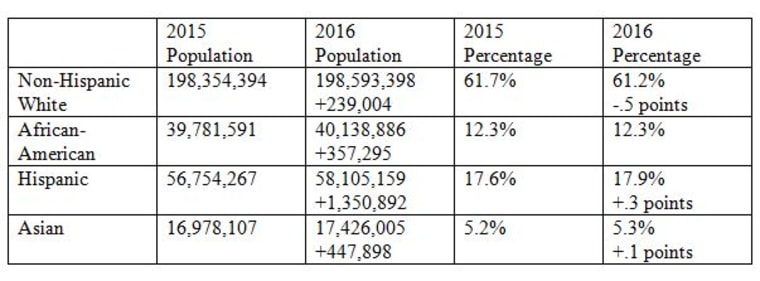When Americans go to the polls on Election Day next November, the United States will be a different place: The population will be a little less white, a bit more Hispanic and slightly more Asian. It will also be a little bit older as the Baby Boom generation continues its march from the workforce toward retirement.
All these changes will play a role in defining the 2016 election because they will alter the contours of the electorate. Each of those demographic slices brings with it different political attitudes and perceptions – leftward and rightward leanings – that manifest themselves at the ballot box.
The shifts over the next year may not be decisive on their own, but they are part of the complicated math problem that defines who we are as a nation and who we are becoming. Adding births and immigration inflows and subtracting deaths and emigration outflows provides a glimpse at the changing face of America.
Small Numbers, Big Changes
In total, there will be 2.6 million more people living in the United States next November than there are today, according to the estimates from the U.S. Census. And all the main racial and ethnic groups will see growth, but that growth will not be distributed evenly.
Non-Hispanic white Americans are still the largest racial/ethnic group in the United States and there will about 239,000 more of them next November. But as their numbers grow, they will actually become a slightly smaller part of the whole, falling from 61.7 percent of the population to 61.3 percent.
That percentage shrinks a little bit each year and, politically speaking, that’s not good news for Republicans. Non-Hispanic whites are one of the GOP’s most reliable voting blocs. In 2012 Republican Mitt Romney won those voters by 20 points, 59 percent to 39 percent for President Barack Obama.
How is it there will be more non-Hispanic whites but they will be a smaller part of the population next Election Day? Because the big minority groups will add more people by next November, in some cases many more.

Hispanic Growth Surging
The growth among Hispanics in the above table is particularly remarkable. There will be 1.3 million more Hispanics living in the United States next November than there are today. That’s half of the total 2.6 million in growth. Growth in Hispanics older than 18 (the legal voting age) alone, is estimated to be 1.1 million, according to Census. And that’s potentially very good news for Democrats. In 2012, Mr. Obama won 71 percent of the Hispanic vote.
In fact, the above table seems to be full of good news for Democrats. All the growing groups – are reliably Democratic in their voting habits. Mr. Obama also won 73 percent of the Asian vote and an astounding 93 percent of African-American voters.
Not Yet A Plurality Nation
These numbers represent the annual impact of the long march toward the plurality nation that sits on the horizon. The Census currently projects that the United States will become “majority minority” in 2044 – meaning that is the year non-Hispanic whites will make up less than 50 percent of the population.
And all these shifts look much more dramatic when you look at how the 2016 numbers compare to 2012.
But Republicans will still have a few points in their favor in the America that goes to the polls in Election Day 2016.
First, all that new population that leans Democratic does not necessarily translate to new Democratic voters. There are, of course, questions of citizenship as anyone who has followed this campaign and the immigration debate around it knows. These numbers measure people, not eligible or registered voters.
Second, there is the other big factor in the changing face of America: it’s growing grayer. A big chunk of the Baby Boomers, the group that has defined politics for the last few decades, is moving from the workforce into retirement every year and 2016 is not an exception.
By next November there will be an additional 1.5 million Americans over the age of 65 and that’s a voter segment that’s been very good to the GOP. Mr. Romney won 56 percent of the 65-or-older vote in 2012.
Of course, there’s no knowing if the political lean of these many demographic slices will continue through 2016 – if Hispanics will remain as reliably Democratic or retirees will stay as strongly Republican. But the larger point is clear.
In 12 months the composite picture of the American electorate will be a shade less white, a bit more gray and still evolving into something different.